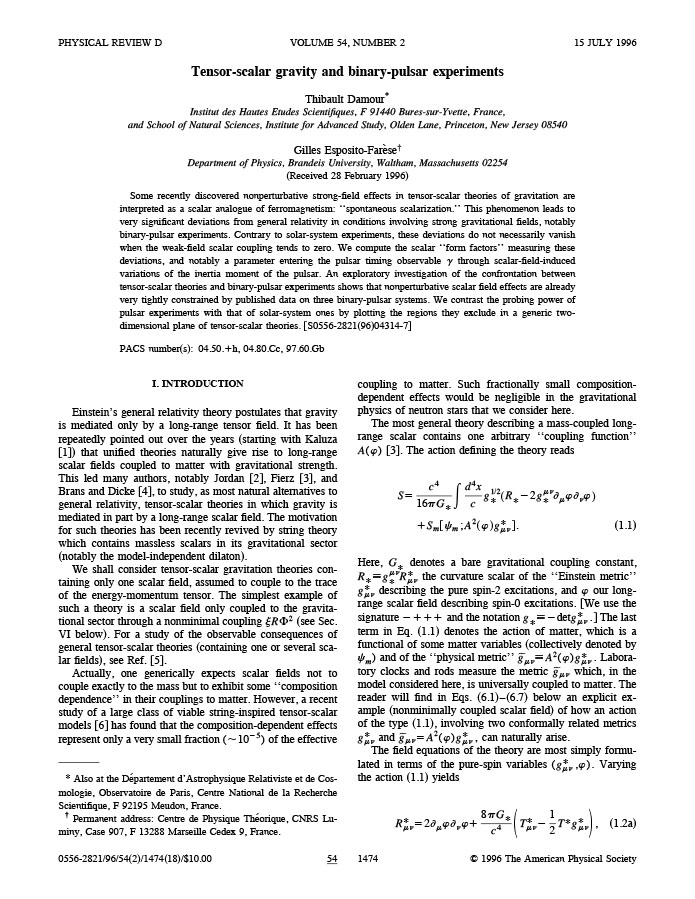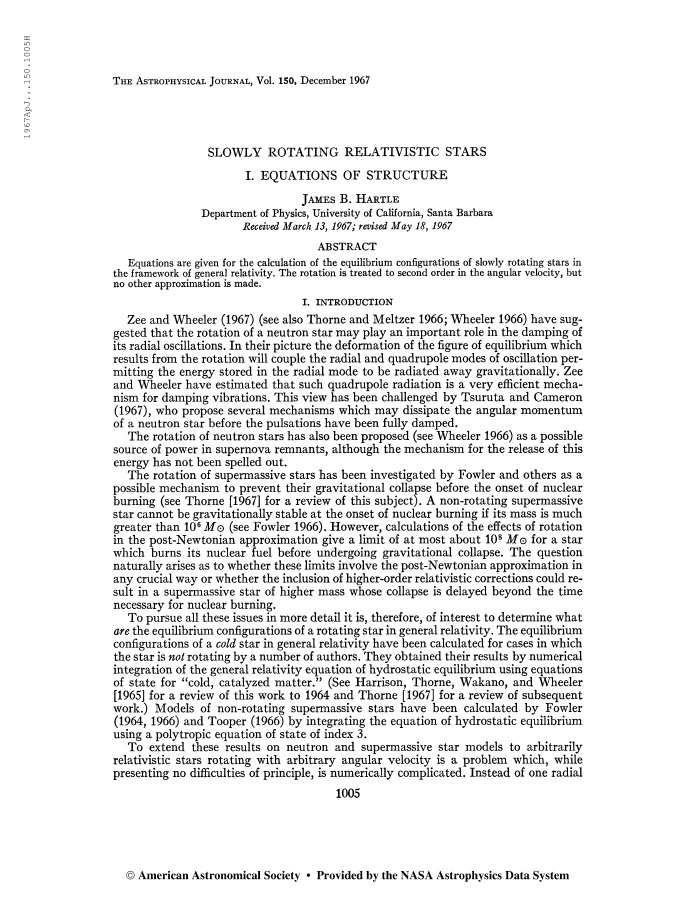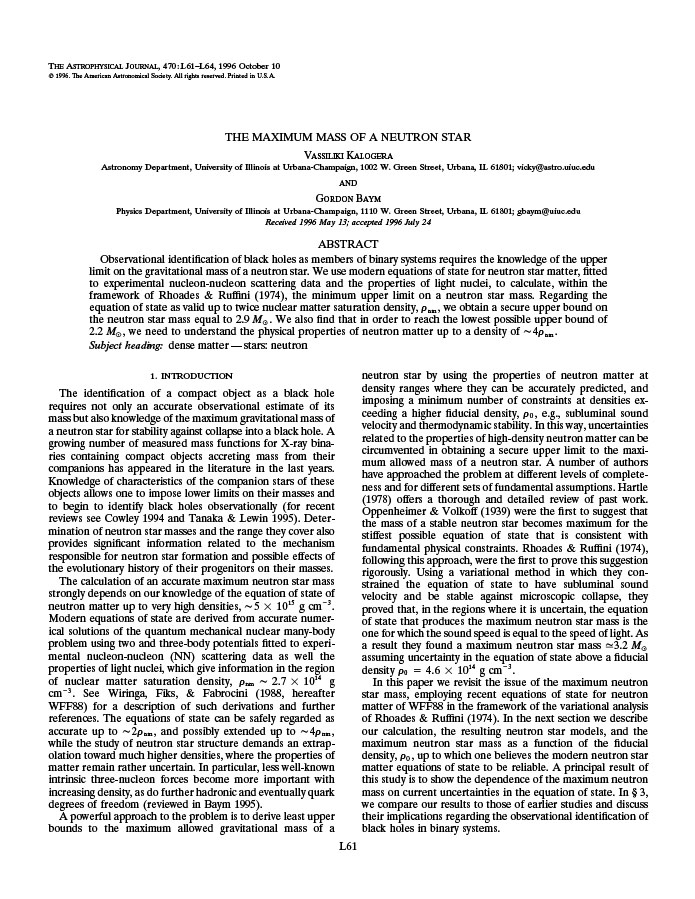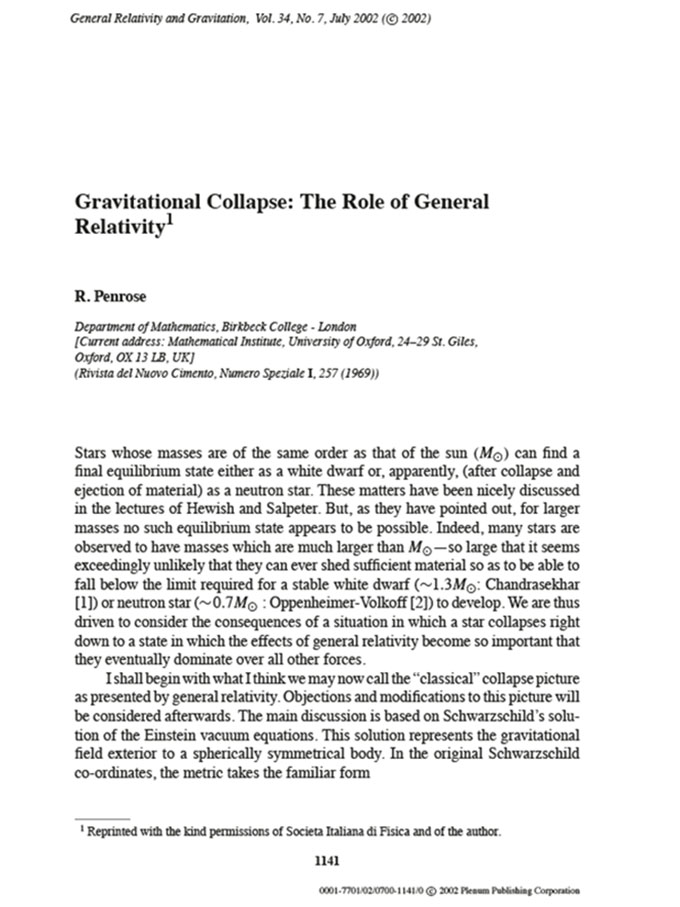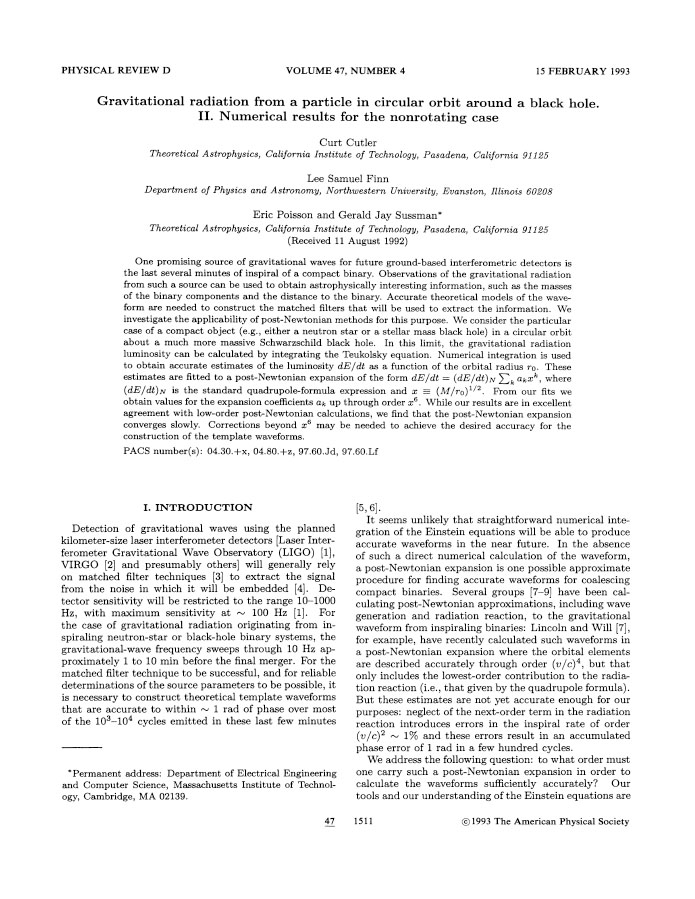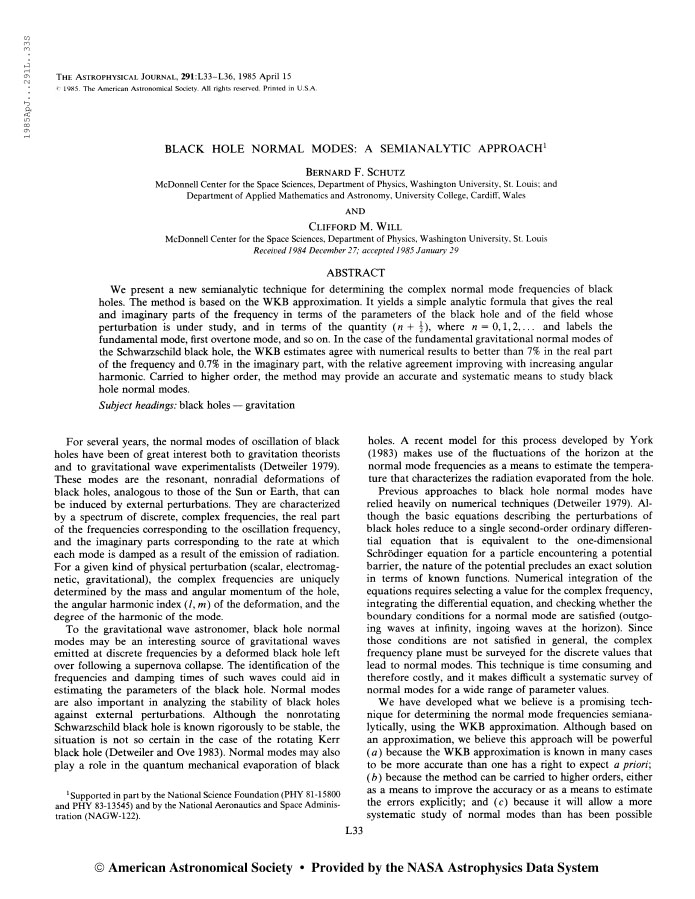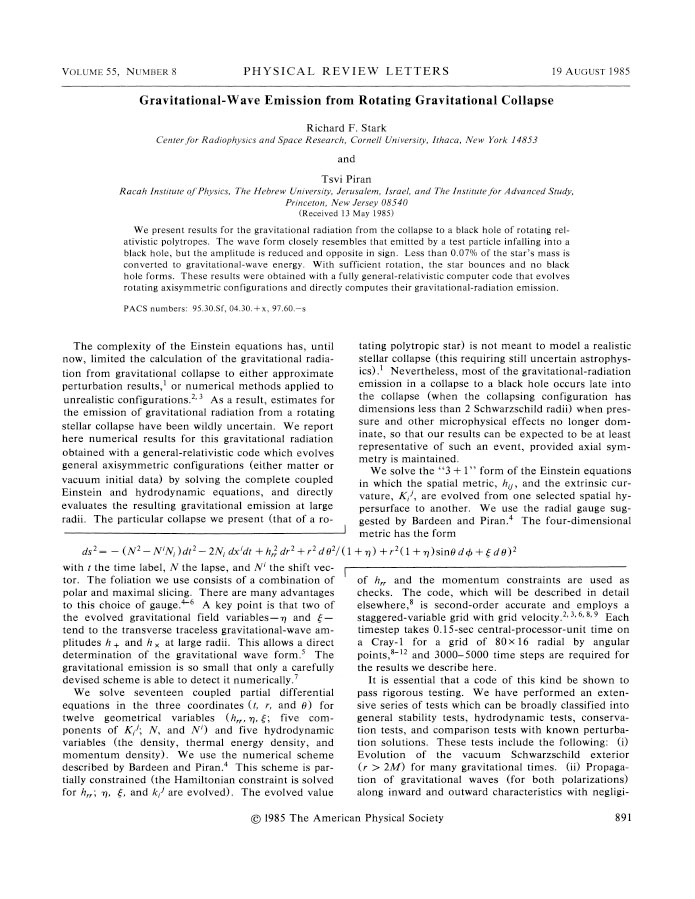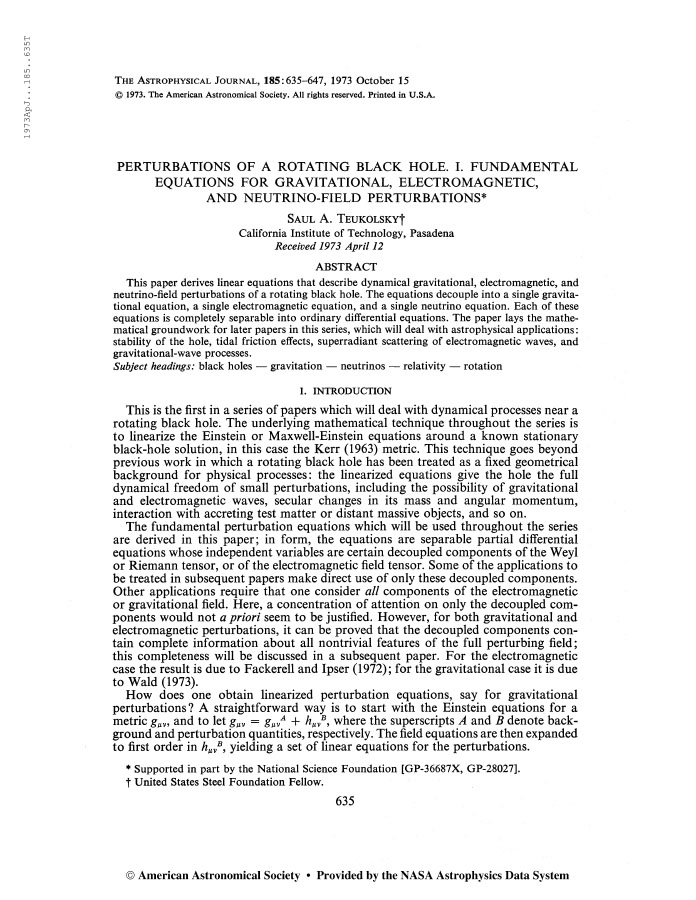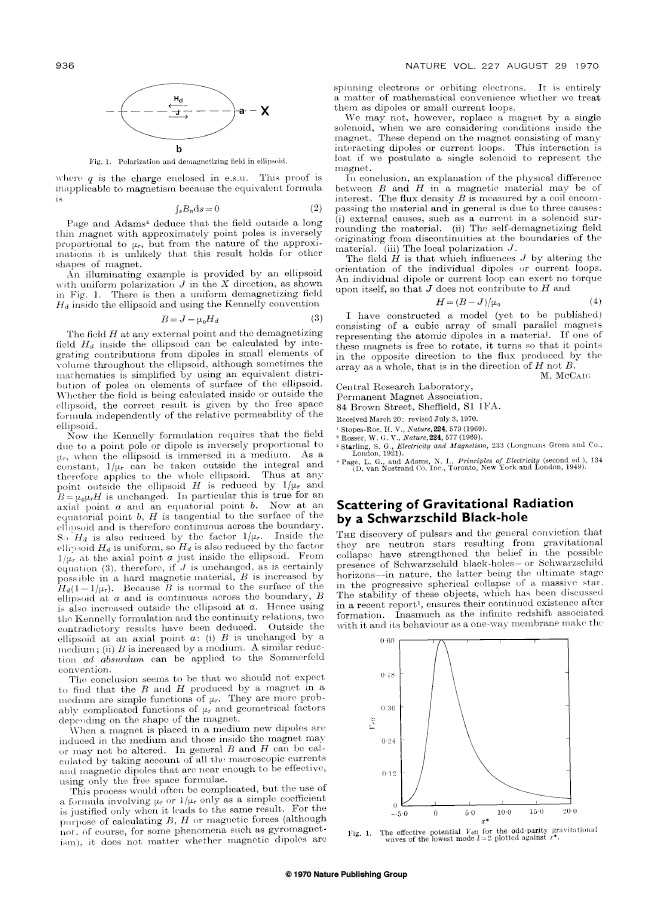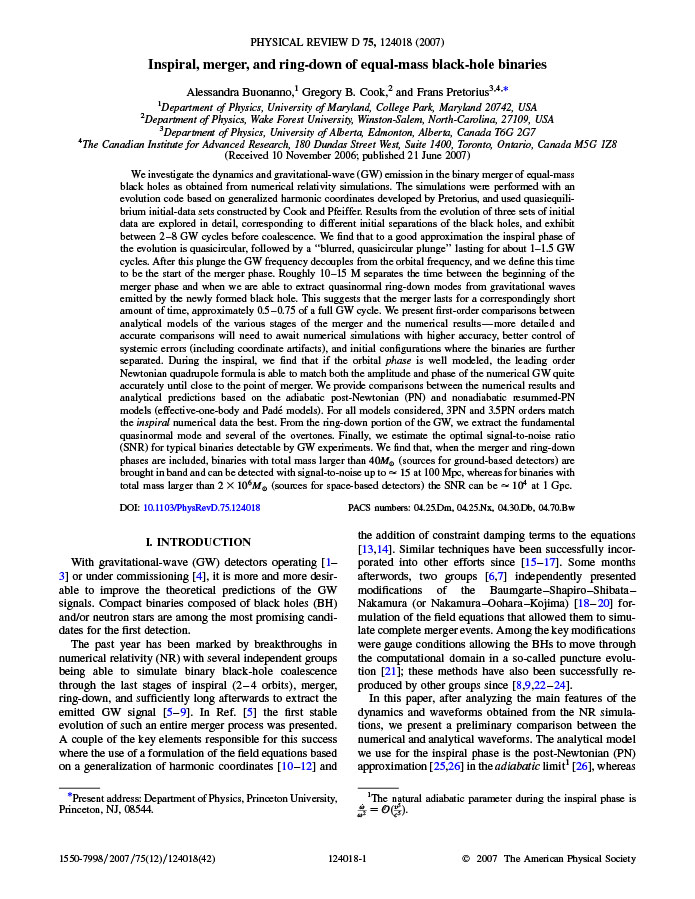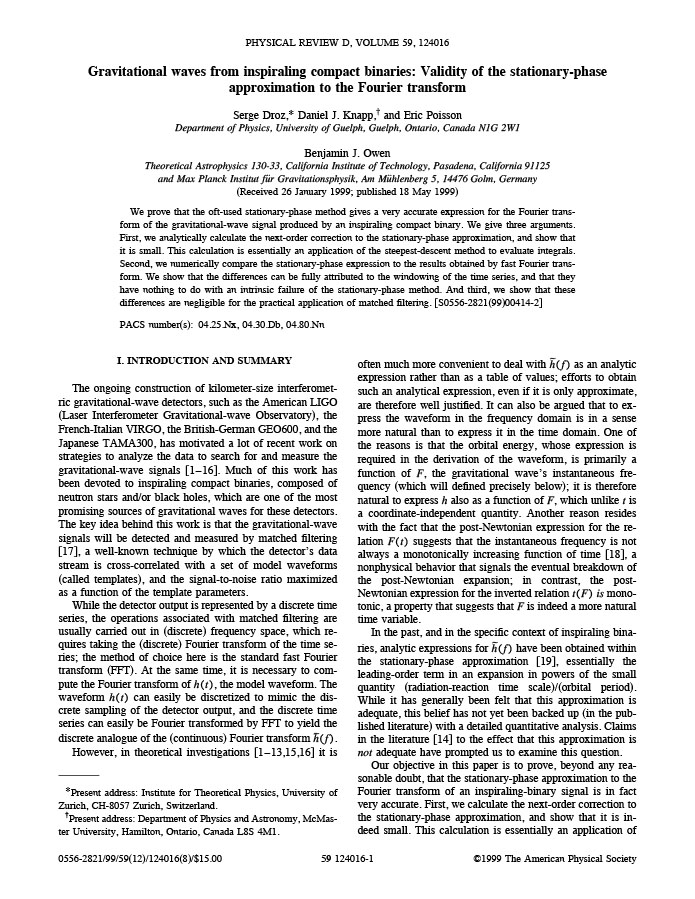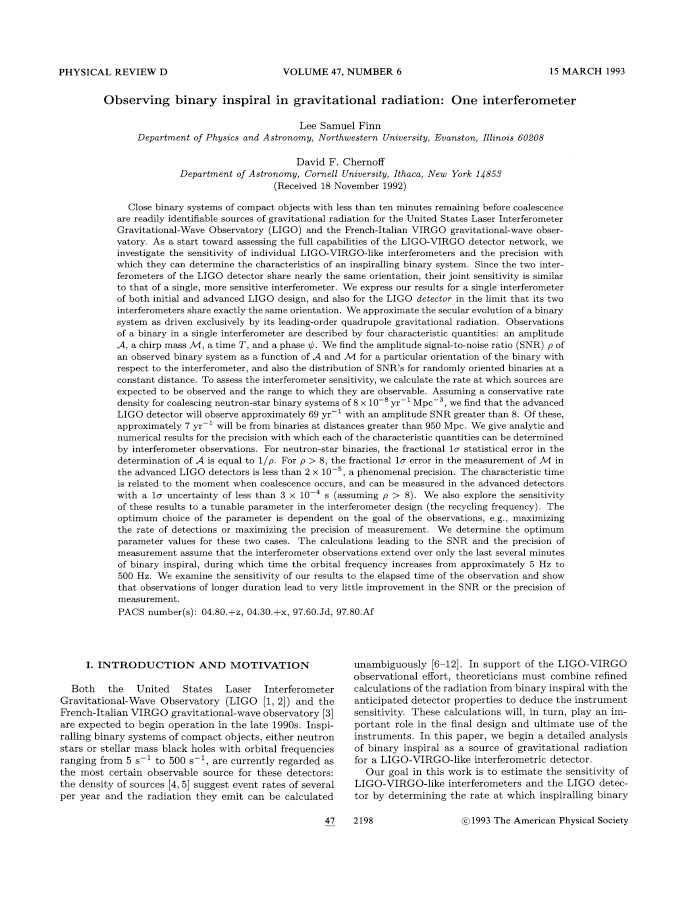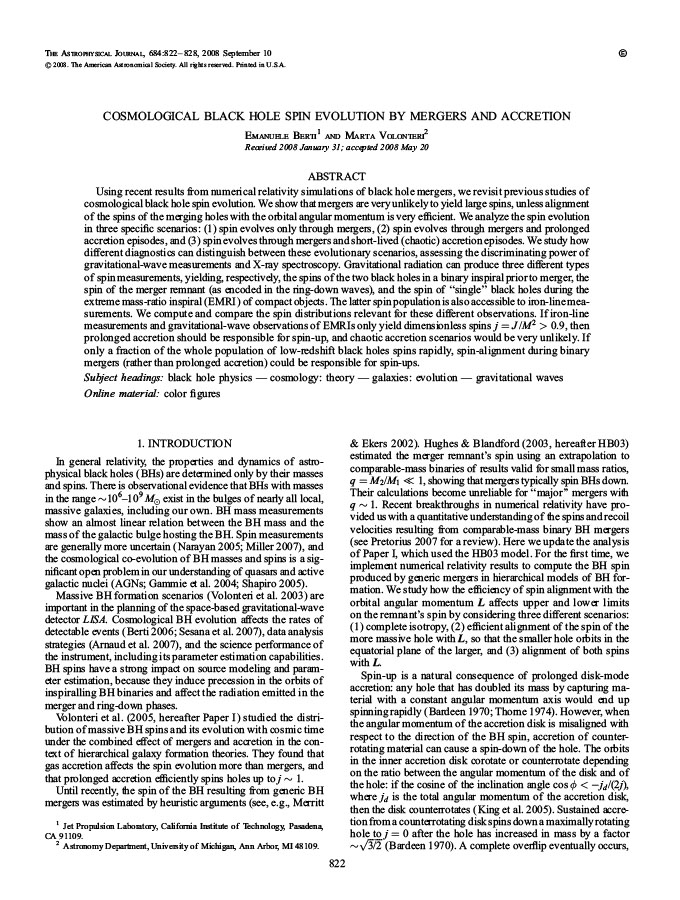
-
The Dynamics of General Relativity
by Richard Arnowitt, Stanley Deser, Charles W. Misner
This article summarizes the authors’ novel formulation of General Relativity, which played and continues to play a fundamental role in numerical relativity, approaches to quantum gravity, etc.
-
Black Holes and Entropy
by Jacob D. Bekenstein
One of the greats. Bekenstein introduces the concept of entropy based solely on analogy between the laws of black hole mechanics and thermodynamics.
-
Generalized Second Law of Thermodynamics in Black-Hole Physics
by Jacob D. Bekenstein
…and now Bekenstein shows the generalized second law of black hole mechanics, together with a few other consequences.
-
Interaction of Neutrinos and Gravitational Fields
by Dieter R. Brill and John A. Wheeler
Gravitational effects on the physics of neutrinos. Still a classic. It includes the identification of spin-orbit coupling terms, comparisons of energy spectrum with other particles, neutrino pair creation without beta interactions, etc, and finally the constitution of a geon.
-
The Confrontation between General Relativity and Experiment
by Clifford Will
How well does General Relativity describe the gravitational interaction? The answer is here. From the post-Newtonian framework to all sorts of magnificent tests.
-
Boson Stars Gravitational Equilibria of Self Interacting Scalar Fields
by Monica Colpi, Stuart L. Shapiro and Ira Wasserman
Generalizes Ruffini and Bonazzola’s construction to self-interacting fields. The literature is huge See the review by Liebling and Palenzuela.
-
Nonperturbative Strong Field Effects in Tensor Scalar Theories of Gravitation
by Thibault Damour and Gilles Esposito-Farèse
First introduction to the concept of spontaneous scalarization: non trivial scalar profiles stars in scalar-tensor theories, triggered by high compactness (avoiding solar system constraints). The authors show how it gives rise to interesting new channels of radiation.
-
Tensor Scalar Gravity and Binary Pulsar Experiments
by Thibault Damour and Gilles Esposito-Farèse
Thorough investigation of non perturbative effects (i.e. spontaneous scalarization) around static and slowly rotating neutron stars. The analogy with spontaneous ferromagnetism is developed, as well as the confrontation with binary pulsar observations.
-
Slowly Rotating Relativistic Stars Part I
by James B. Hartle
A complete relativistic extension of the Newtonian theory is presented here. Hartle derives the equations describing a relativistic star in hydrostatic equilibrium using a second order approximation in the angular velocity.
-
Slowly Rotating Relativistic Stars Part II
by James B. Hartle and Kip S. Thorne
In this second work, equations derived in Paper I are solved numerically for different equations of state. In particular, the authors focus on white dwarfs, neutron stars and supermassive stars.
-
Gravitationally Collapsed Objects of Very Low Mass
by Stephen Hawking
Hawking develops the physics of primordial black holes. Very light black holes should evaporate in a flash and not survive till today. More massive black holes can. Primordial black holes as source of recent GW observations are in fashion. For recent reviews see Carr.
-
The Maximum Mass of a Neutron Star
by Vassiliki Kalogera and Gordon Baym
Neutron stars should not have more than 2.9 solar masses. The absolute maximum mass of a neutron star provides a decisive method of observationally distinguishing neutron stars from black holes.
-
Gravitational Action With Null Boundaries
by Luis Lehner, Robert C. Myers, Eric Poisson and Rafael D. Sorkin
A self-contained and detailed source on the action functional of general relativity, discussing boundaries of all types (spacelike, timelike, null). Known results are collected and the ambiguities of null boundaries are clarified. A useful "Action user's manual" is provided at the end.
-
Gravito Electromagnetism
by Roy Maartens and Bruce A Bassett
An almost perfect analogy between electromagnetism and gravity was laid down by Heaviside in 1893. The authors show how it carries, in a rigorous way, to General Relativity.
-
On continued Gravitational Contraction
by J. R. Oppenheimer and H. Snyder
The first study of gravitational collapse to the very end of it. This classic taught us how collapse proceeds and how we should think about black holes.
-
Maximum Mass of a Neutron Star
by Clifford E. Rhoades and Remo Ruffini
On the basis of Einstein's theory of relativity, the principle of causality, and Le Chatelier's principle, it is here established that the maximum mass of the equilibrium configuration of a neutron star cannot be larger than 3.2 solar masses. You need to read also Oppenheimer and Volkoff.
-
Gravitational collapse and spacetime singularities
by Roger Penrose
Physically reasonable spacetimes are singular. This realization was extended in different ways, see also Natário’s exposition.
-
Gravitational Collapse: The Role of General Relativity
by Roger Penrose
Gravitational collapse leads to singularities, so Penrose decised a cosmic censor! He also understood how to extract energy from rotating black holes, using test particles and the existence of ergoregions in curved spacetimes (important generalizations by Piran and Schnittman).
-
Systems-of-Self Gravitating Particles in General Relativity and the Concept of an Equation of State
by Remo Ruffini and Silvano Bonazzola
Expanding on Wheeler’s geons, this work deals with the physics and mathematics of self-gravitating bound systems formed by fermions or bosons. Boson stars descend from this classic.
-
Black Hole Entropy is Noether Charge
by Robert M. Wald
The first law of black hole mechanics is not special to General Relativity!
-
Geons
by John Archibald Wheeler
Can waves be trapped by their own gravity, forming gravitational entities, geons? Can we explain elementary particles or electromagnetism without singularities in this way? This is what this seminal work deals with.
-
Light Rays Singularities and All That
by Edward Witten
An introduction to causal properties of General Relativity. Topics include the Raychaudhuri equation, singularity theorems of Penrose and Hawking, the black hole area theorem, topological censorship, and the Gao-Wald theorem
-
The Hypothesis of Cores Retarded During Expansion and the Hot Cosmological Model
by Zel'dovitch amd Novikov
Zel'dovitch & Novikov deal with primordial black holes in 1966.
-
Exploring the String Axiverse with Precision Black Hole Physics
by Asimina Arvanitaki and Sergei Dubovsky
Superradiant instabilities attracted attention because their turn anti-de Sitter spacetimes unstable, and because they can be used to constraint the matter content of the universe. This paper started it. See also the Lecture Notes by Brito et al.
-
Rotating Black-Holes: Locally Nonrotating Frames, Energy Extraction, and Scalar Synchrotron Radiation
by James M. Bardeen, William H. Press, Saul A. Teukolsky
Everyting you wanted to know about the Kerr spacetime is here.
-
Probing ultralight bosons with binary black holes
by Daniel Baumann, Horng Sheng Chia and Rafael A. Porto
This is an elegant analysis of superradiant clouds and tidal effects using tools borrowed from quantum mechanics.
-
Relativistic theory of tidal Love numbers
by Taylor Binnington and Eric Poisson
Develops the formalism to study stationary tidal deformations in GR and applies it to compute the tidal Love numbers of neutron stars (see also chapter 2.5 of Poisson and Will and Hinderer and Flanagan’s seminal work).
-
Quasinormal Modes and Strong Cosmic Censorship
by Vitor Cardoso, João L. Costa, Kyriakos Destounis, Peter Hintz and Aron Jansen
Classical, Strong Cosmic Censorship may not be upheld in de Sitter spacetimes, in the presence of charge. See also Hollands et al, for possible impact of quantum effects.
-
The Black Hole Bomb and Superradiant Instabilities
by Vitor Cardoso, Óscar J. C. Dias, José P. S. Lemos and Shijun Yoshida
This is one example of Press and Teukolsky’s predictions, shown to be correct: the black-hole bomb. This work also predicted the instability of rotating black holes in anti-de Sitter Universe, shown later to be correct, see Cardoso et al.
-
Is the Gravitational-Wave Ringdown a Probe of the Event Horizon?
by Vitor Cardoso, Edgardo Franzin and Paolo Pani
No. Ringdown, as seen by LIGO, is related to the photon sphere. In the absence of horizons, echoes of the original signal will dictate the late time relaxation. See review by Cardoso and Pani.
-
Testing the Nature of Dark Compact Objects: a Status Report
by Vitor Cardoso and Paolo Pani
Do black holes exist? How can we quantify the presence of horizons in our universe?
-
On the non-radial Oscillations of a star III. A reconsideration of the Axial Modes
by S. Chandrasekhar and Valeria Ferrari
A classic, and not only on black hole physics.
-
Universality and Scaling in Gravitational Collapse of a Massless Scalar Field
by Matthew W. Choptuik
Minkowski is stable, but large initial data collapses to black holes. What happens at the threshold of black hole formation? Choptuik’s remarkable study finds critical phenomena, power-law scaling and echoing. The ‘critical solution between collapse and dispersion is an example of a naked singularity. See Gundlach & Martı́n-Garcı́a overview.
-
On the Ergoregion Instability
by N. Comins and B. F. Schutz
Spacetimes with ergoregions but without horizons are unstable. See follow-up by Moschidis, and physical consequences in the Lecture Notes by Brito et al.
-
The Many Definitions of a Black Hole
by Erik Curiel
Decades after the understanding of black hole spacetimes, black holes are still cause for debate. Here’s an excellent discussion on what black holes are, from various viewpoints.
-
Relativistic Tidal Properties of Neutron Stars
by Thibault Damour and Alessandro Nagar
Very similar work to “Relativistic theory of tidal Love numbers” by Binnington and Poisson (written independently by the two groups and published at the same time).
-
The Quasi-Normal Modes of the Schwarzschild Black Hole
by S. Chandrasekhar and S. Detweiler
Chandrasekhar and Detweiler’s classic, where a direct integration method is used to compute, for the first time, the quasinormal modes of black holes.
-
Klein-Gordon Equation and Rotating Black Holes
by Steven Detweiler
A small fluctuation of a light scalar field will grow exponentially close to a rotating black hole. This was shown via matched asymptotics, and establishes the proposal by Damour, Deruelle & Ruffini and the WKB results by Zouros and Eardley.
-
Instability of the Massive Klein-Gordon Field on the Kerr Spacetime
by Sam R. Dolan
The results by Detweiler were confirmed numerically by Cardoso & Yoshida (and shown not to extend to higher dimensions). Later, Sam Dolan explored thoroughly the subject in this beautiful work.
-
New Approach to the Quasi-Normal Modes of a Black Hole
by Valeria Ferrari and Bahram Mashhoon
A relation is established between the null circular geodesics and the quasinormal modes. The derivation was simplified and the results extended to arbitrary spacetimes in Cardoso et al. 2009.
-
Constraining Neutron-Star Tidal Love Numbers with Gravitational-Wave Detectors
by Éanna É. Flanagan and Tanja Hinderer
Here’s how to use LIGO observations to measure the tidal Love numbers of neutron stars (which have by now been measured), but the formalism can be extended to any GW detector and compact object.
-
Spacetime Approach to Force-Free Magnetospheres
by Samuel E. Gralla and Ted Jacobson
An elegant description of force-free environments, opening a new window into this subjectType a message.
-
Particle Creation by Black Holes
by S. W. Hawking
Yes, black holes evaporate once quantum mechanics is brought into the game. This work was refined in many different ways, including the calculation of greybody factors by Don Page, and many many other issues.
-
Kerr Black Holes with Scalar Hair
by Carlos Herdeiro and Eugen Radu
Theorems are valid under certain assumptions…when these are not met, new things happen. A black hole surrounded by a scalar field is possible as an equilibrium solution of the field equations.
-
Gravitational Field of a Spinning Mass as an Example of Algebraically Special Metrics
by Roy Kerr
The 1963 work where the Kerr geometry is shown for the first time.
-
Analytic Solutions of the Teukolsky Equation and Their Low Frequency Expansions
by Shuhei Mana, Hisao Suzuki and Eiichi Takasugi
The title says it all, an important reference in black hole physics, allowing accurate calculations of waveforms.
-
On the Means of Discovering the Distance, Magnitude…
by John Michell
We think of black holes as a 20th century invention, dating back to 1916. But the true “father” of the black hole concept was a humble 18th century English rector named John Michell–a man so far ahead of his scientific contemporaries that his ideas languished in obscurity.
-
Stability of Stationary, Spherical Accretion onto a Schwarzschild Black Hole
by Vincent Moncrief
This work is remarkable because it predates Unruh’s: Moncrief shows, studying relativistic hydrodynamics of accretion flows surrounding black holes, that an effective metric arises. Sound waves “see” a metric that is controlled by the background flow.
-
Black Hole Perturbation
by Yasushi Mino, Misao Sasaki, Masaru Shibata, Hideyuki Tagoshi and Takahiro Tanaka
A compendium on analytical and numerical results for collapse and gravitational radiation by point particles around black holes.
-
Gravitational Radiation from a Particle in Circular Orbit Around a Black-Hole II. Analytical Results for the Nonrotating Case
by Eric Poisson, Curt Cutler, Lee Samuel Finn, Gerald Jay Sussman
Continuation of the above work, it had to be on this list too. See also follow ups, papers III, IV, etc.Type a message
-
Inner-Horizon Instability and Mass Inlation in Black Holes
by Eric Poisson and W. Israel
Some black hole spacetimes have Cauchy horizons, signalling the breakdown of physics (of predictability). Fortunately Poisson and Israel showed that they are unstable, uncovering a (Strong) Cosmic Censor.
-
Long Wave Trains of Gravitational Waves from a Vibrating Black Hole
by William H. Press
Here’s how Press estimates analytically the quasinormal mode frequencies.
-
Stability of a Schwarzschild Singularity
by Tullio Regge and John A. Wheeler
This classic, done before black holes were even accepted, teaches us how to separate gravitational fluctuations with tensor harmonics.
-
Nonspherical Perturbations of Relativistic Gravitational Collapse. I. Scalar and Gravitational Perturbations
by Richard Price
After ringdown, backscattering off spacetime curvature gives rise to power-law tails. These are Price’s tails, completing the approach to a no-hair object…but tails are generic features of curved spacetime.
-
Uniqueness of the Kerr Black Hole
by D. C. Robinson
And, extending the work by Israel, Robinson shows that Kerr is unique! This is part of the uniqueness or no-hair results in black hole physics. For more recent reviews, see Chrusciel & Costa, Cardoso & Gualtieri, Herdeiro & Radu, and Israel’s account in 300 Years of Gravitation.
-
Black Hole Normal Modes: A Semianalytic Approach
by Bernard F. Schutz and Clifford M. Will
A WKB approach to the quasinormal modes of black holes. See improvements by Konoplya and Matyjasek & Telecka.
-
Gravitational-Wave Emission from Rotating Gravitational Collapse
by Richard F. Stark and Tvsi Piran
Pioneering work on gravitational wave emission from collapse with angular momentum.
-
Floating Orbits, Superradiant Scattering, and the Black-Hole Bomb
by William Press and Saul Teukolsky
A delight to read. Superradiance is claimed to give rise to instabilities and strange orbital phenomena. All of these predictions were later confirmed. See the Lecture Notes by Brito et al for a comprehensive overview.
-
Perturbations of a Rotating Black Hole I. Fundamental Equations for Gravitational, Electromagnetic, and Neutrino-Field Perturbations
by Saul A. Teukolsky
Regge-Wheeler-Zerilli’s approach doesn’t work with rotation. But Teukolsky showed how to study, decouple and separate linearized fluctuations in a Newman-Penrose approach. See also the follow-ups by Teukolsky and Press.
-
Notes on Black-Hole evaporation
by William Unruh
Unruh looks into a number of aspects related to Hawking radiation. Among others, he shows that accelerated detectors must also see radiation, even in flat spacetime.
-
Experimental Black-Hole evaporation
by William Unruh
Unruh realizes, independently from Moncrief, that fluid dynamics can mimic some aspects of general relativity. In particular, sound waves behave formally as a scalar field in curved spacetime. Water can mimic black holes! Analogue gravity now has a long history, see the reviews by Visser and Barceló et al.
-
Scattering of Gravitational Radiation by a Schwarzschild Black Hole
by Channapattana V. Vishveshwara
Black holes have no hair…but how do they lose it? Here’s a classic: the scattering of Gaussian pulses show that fluctuations die off as damped sinusoids. These are the characteristic vibration modes of black holes, the quasinormal modes. See review 1, review 2, and review 3 for the state of the art.
-
Amplification of Cylindrical Electromagnetic Waves Reflected from Rotating Body
by Yakov Zel’dovich
Zel’dovich shows that rotating bodies are able to amplify low-frequency radiation. This classical process is known as superradiance, the analogue of the Penrose process for waves. For a recent review on this process see these Lecture Notes from Springer.
-
Gravitational Field of a Particle Falling in a Schwarzschild Geometry Analyzed in Tensor Harmonics
by Frank J. Zerilli
Continuing Regge and Wheeler’s work, Zerilli combined the polar gravitational fluctuations into a single master function. It’s a classic with a number of typos (see Berti’s list of typos)
-
Transition from Inspiral to Plunge in Binary Black Hole Coalescences
by Alessandra Buonanno and Thibault Damour
A remarkable work in which the nascent EOB formalism was used to provide, for the first time, a complete model for the gravitational waveform for the inspiral, merger and ringdown of a binary black hole system.
-
Spin-Induced Orbital Precession and its Modulation of the Gravitational from Merging Binaries
by Theocharis A. Apostolatos, Curt Cutler, Gerald Sussman and Kip S. Thorne
When at least one constituent of a compact binary system is (generically) spinning the orbital plane will precess. The resulting modulation of the waveform is both subtle and interesting. Here the authors use a PN approach to describe this behavior.
-
Estimating Spinning Binary Parameters and Testing Alternative Theories of Gravity with LISA
by Emanuele Berti, Alessandra Buonanno and Clifford M. Will
The determination of binary parameters from waveforms is crucial. The authors examine binaries relevant to space-based detectors, within both GR and alternative theories. They find orders of magnitude degradation in the determination for alternative theories.
-
Gravitational-Wave Spectroscopy of Massive Black Holes with the Space Interferometer LISA
by Emanuele Berti, Vitor Cardoso and Clifford M. Will
Presentation of a formalism to detect ringdown signals, from which parameters of the associated BHs can be read off. The associated SNR for LISA is examined.
-
Inspiral, Merger, and Ringdown of Unequal Mass Black Hole Binaries: A Multipolar Analysis
by Emanuele Berti, Vitor Cardoso José A. Gonzalez, Ulrich Sperhake, Mark Hannam, Sascha Husa and Bernd Brügmann
BBHs of different mass ratios are studied. Numerical data are compared to PN results and the relative strengths of the multipoles examined. Again the PN results are surprisingly good (at least in comparison with the expectations of the time).
-
Inspiral, Merger, and Ring-Down of Equal-Mass Black-Hole Binaries
Alessandra Buonanno, Gregory B. Cook and Frans Pretorius
Here, in one of the first works towards the systematic interface of numerical and analytical relativity, BBHs of equal mass ratio are studied. The PN approximation gradually becomes less accurate through the inspiral, but specific quantities are surprisingly well-described.
-
Effective One-Body Approach to General Relativistic Two-Body Dynamics
by Alessandra Buonanno and Thibault Damour
In a fantastic, and fantastically influential paper, an approach for modeling the relativistic two-body problem is introduced. The idea is to map the dynamics on to that of a test body moving in an effective spacetime. EOB is now used in most GW data analysis.
-
Comparison of Post-Newtonian Templates for Compact Binary Inspiral Signals in Gravitational-Wave Detectors
by Alessandra Buonanno, Bala R. Iyer, Evan Ochsner, Yi Pan, and B. S. Sathyaprakash
There are various PN approximations even at the same (formal) expansion order. In this paper different approximations are compared with each other and with EOB. For small binaries all behave comparably for detection. For large mass binaries EOB is favorable.
-
Gravitational Radiation Reaction for Bound Motion Around a Schwarzschild Black Hole
by Curt Cutler, Daniel Kennefick and Eric Poisson
An elegant description of gravitational wave generation by “point particles” (stars or stellar-mass BHs) around large black holes. Analytical results are worked out, and the procedure to expand in higher powers of velocity is laid out. Beautiful.
-
Gravitational waves from merging compact binaries: How accurately can one extract the binary’s parameters from the inspiral waveform?
by Curt Cutler and Éanna E. Flanagan
An important study of the extraction of binary parameters from the waveform. Particular attention is paid to the obstruction that spin plays to the evaluation of the constituent masses.
-
Angular Resolution of the LISA Gravitational Wave Detector
by Curt Cutler
The strategy for source characterization for a (single) space based detector necessarily differs from that of a network of ground-based detectors. In this paper the determination of source position is considered for such an experiment.
-
The Last Three Minutes: Issues in Gravitational Wave Measurements of Coalescing Compact Binaries
by Curt Cutler, Theocharis A. Apostolatos, Lars Bildsten, L. Samuel Finn, Eanna E. Flanagan, Daniel Kennefick, D. M. Markovic, Amos Ori, Eric Poisson, Gerald J. Sussman and Kip S. Thorne
Everything you want to know about neutron stars and gravitational wave detection is somehow condensed here, at a time when neutron stars were thought to be the most abundant sources of gravitational waves.
-
Pulsar Timing Measurements and the Search for Gravitational Waves
by Steven Detweiler
A true classic. Detweiler understand how to use an array of pulsars as clocks, with which to detect the passing of a gravitational wave.
-
Gravitational Waves from Inspiraling Compact Binaries: Validity of the Stationary-Phase Approximation to the Fourier Transform
by Serge Droz, Daniel J. Knapp, Eric Poisson and Benjamin J. Owen
The title says it all.
-
Observing Binary Inspiral in Gravitational Radiation One Interferometer
by Lee Samuel Finn and David F. Chernoff
All of the enchilada of physics and data analysis necessary to claim a detection of gravitational waves is explored here. See also Flanagan and Hughes classic.
-
Detection Measurement and Gravitational Radiation
by Lee Samuel Finn
If you want to know how gravitational waves are detected, start by reading this.
-
Measuring Gravitational Waves from Binary Black Hole Coalescences. I. Signal to Noise for Inspiral, Merger, and Ringdown
by Éanna É. Flanagan and Scott A. Hughes
Just read it.
-
Gravitational Radiation from a Particle in Circular Orbit Around a Black-Hole I. Analytical Results for the Nonrotating Case
by Eric Poisson
An elegant description of gravitational wave generation by “point particles” (stars or stellar-mass BHs) around large black holes. Analytical results are worked out, and the procedure to expand in higher powers of velocity is laid out. Beautiful.
-
Evolution of Binary Black-Hole Spacetimes
by Frans Pretorius
Pretorius presents for the first time a solution to the two-body problem in general relativity: a non-linear evolution of a black hole binary through inspiral, merger, and ringdown. The numerical code employed uses generalized harmonic coordinates to evolve the system and the gravitational wave signal emitted during merger. This was an outstanding problem in gravity and marks a major breakthrough in the field of numerical relativity.
-
Laws of Motion and precession for Black Holes and Other Bodies
by Kip S. Thorne and James B. Hartle
Corrections to the geodesic law of motion and Fermi-Walker law of transport, due to the coupling of a body's angular momentum and quadrupole moment to the Riemann curvature of the surrounding spacetime, are derived for any isolated body with slowly varying multipole moments.
-
Gravitational-Wave Bursts with Memory: The Christodoulou Effect
by Kip S. Thorne
The memory of a GW burst is a permanent relative displacement between free test masses. The Christodoulou memory arises from nonlinearities in the Einstein equations. This article estimates its order of magnitude as well as its detection prospects for ground-based and space interferometers.
-
Multipole Expansions of Gravitational Radiation
by Kip S. Thorne
A consolidation of the different multipole expansion formalisms developed in the literature of gravitation. In addition, Thorne introduces the "local wave zone" and provides algorithms and formulas for analytic approximations of gravitational radiation, widely used thereafter.
-
Christodoulous Nonlinear Gravitational Wave Memory Evaluation in the Quadrupole Approximation
by Alan G. Wiseman and Clifford M. Will
The nonlinear memory effect is caused by the stress-energy of a gravitational wave itself and induces a 10% correction to the leading waveform for BNS systems.
-
Cosmological Black Hole Spin Evolution by Mergers and Accretion
by Emanuele Berti and Marta Volonteri
How large is the spin of black holes in the cosmos ?
-
Electromagnetic Extraction of Energy from Kerr Black Holes
by R. D. Blandford and R. L. Znajek
Although still unclear in some aspects, here’s a way that black holes can power luminous events.
-
Dynamical Friction
by Subramanyan Chandrasekhar
Dynamical friction on stars in the universe, caused by gravitational drag. A true classic.
-
On The Accretion Theory of Stellar Evolution
by Fred Hoyle and R. A. Lyttleton
Initiates the study of accretion onto compact objects. See the follow ups by Bondi & Hoyle and Bondi and a more recent review.
-
Dynamical Friction in a Gaseous Medium
by Eve Ostriker
Chandrasekhar’s theory applies to collisionless media. Here’s an elegant and classical work on the gaseous counterpart. Generalizations to slab-like geometries was done by Vicente et al, and the calculation of dynamical friction when the medium is a scalar field was done by Annulli et al.
-
On the mechanism of accretion by stars
by Hermann Bondi and Fred Hoyle
The classic on spherically symmetric steady accretion of matter by a black hole. For a recent review see. For similar processes with fundamental fields, of arbitrary Compton wavelength, see the work by Unruh.
-
Linking the Spin Evolution of Massive Black Holes to Galaxy Kinematics
by A. Sesana, E. Barausse, M. Dotti and E. M. Rossi
Lorem ipsum dolor sit amet, consectetur adipiscing elit. Proin convallis maximus pulvinar. Mauris nec tincidunt tortor. Proin ut turpis at tortor ullamcorper fer- mentum. Mauris consequat vulputate elit.
-
Black Holes in binary Systems. Observational Appearance
by N. I. Shakura and R. A. Sunyaev
A classic on accretion disks.
-
Astrophysics of Black Holes
by Igor D. Novikov and Kip S. Thorne
Everything you need to know to understand accretion disk around black holes. You should read the classic by Shakura-Sunyaev and this more recent Living Reviews on accretion disks by Abramowicz and Fragile.
-
Disk Accretion onto a Black Hole II. Evolution of the Hole
by Kip S. Thorne
Heating effects, together with absorption cross section which is larger for counter-rotating photons, imposes a maximum limit on the black hole spin, J=0.998 M^2.
-
Formation of Supermassive Black Holes by Direct Collapse in Pre-Galactic Haloes
by Mitchell C. Begelman, Marta Volonteri and Martin J. Rees
A formation mechanism of black holes: the “direct collapse” model for black hole seeds.
-
Kerr Metric Black Holes
by James Bardeen
The work that convinced the community to stop using Schwarzschild as a description of black holes. Accretion spins black holes up effectively.







